S-37: Difference between revisions
Pbcjohnston (talk | contribs) Created S-37 page |
Pbcjohnston (talk | contribs) Added new Header |
||
| (5 intermediate revisions by the same user not shown) | |||
| Line 1: | Line 1: | ||
[[File:S- | [[File:New Header EB S-boats.jpg]] | ||
<br> | |||
[[File:S-37 accident.jpg|left|500px]] | |||
<div style="text-align: justify;"><span style="color:#00008B">On the afternoon of October 10, 1923, the newly commissioned S-37 was in port at San Pedro (Los Angeles), CA. She was conducting a battery charge, a seemingly routine activity that can actually turn quite dangerous under the right conditions. About halfway through the charge, an explosion occurred in the after battery compartment. Hydrogen gas is generated when the lead-acid batteries are charged, and it was this highly flammable gas that built up under improper ventilation until a stray spark set it off. Dense black smoke and toxic gas filled the compartment, and flames raged across the deck. Three men were brought out. Two bodies were left behind. One of the rescued died before medical help arrived. Two of the rescuers were seriously injured. The crew battled the fire for several hours unsuccessfully, and finally evacuated and sealed the compartment in an attempt to get the fire snuffed out. It took until 1130 the next day to finally fully extinguish the fire. The after battery compartment was heavily damaged. This photo shows the crew and medical personnel removing the dead and injured through the engine room hatch in the late afternoon of the 10th. Temporary repairs were made, and the boat got underway for the Mare Island Navy Yard near San Francisco where the boat was fully repaired. By mid December, 1923 S-37 was once again back operating with the fleet. | |||
<div style="text-align: justify;"><span style="color:#00008B"> | <small>USN photo NH 69128 courtesy of the NHHC.</small> | ||
[[File:Red bar sub new.jpg]] | |||
[[File:S-37 dd subic.jpg|left|500px]] | |||
<div style="text-align: justify;"><span style="color:#00008B">S-37 sitting high and dry in the Dewey Drydock at Naval Station Subic Bay, Philippines, circa 1925. A Marine guard is on duty on the brow to the dock. Another S-boat is in the dock behind the S-37. | |||
<small>Photo in the private collection of Ric Hedman.</small> | |||
[[File:Red bar sub new.jpg]] | |||
[[File:S-37 fuel.jpg|left|500px]] | |||
<div style="text-align: justify;"><span style="color:#00008B">S-37 conducting a fueling at sea, probably in China waters, approximately 1925. This is the astern fueling method in favor by the USN at the time. It involved the sending ship floating a line back from its fantail. The line was picked up by the receiving boat and used to pull a heavier suspension line and heaving line over, which the receiving boat would secure to a forward mast. The heaving line was then used to pull over the fuel hose, which slid along the suspension line on a series of small roller blocks. The hose was then connected to the fuel manifold in the submarine's superstructure and the fueling itself could then begin. The process was somewhat inefficient, causing the Navy to later adopt the alongside method still in use today. Fueling at sea was a significant tactical advantage which the USN used to great effect in WWII. | |||
<small>Photo in the private collection of Ric Hedman.</small> | |||
[[File:Red bar sub new.jpg]] | |||
[[File:S-37 with canaries.jpg|left|500px]] | |||
This unfortunately poor quality photo shows a very interesting scene. S-37 is underway likely in the South China Sea near the Philippines. The date is approximately 1925-1926. Several crewmembers are topside tending to canaries in cages! This photo comes from the private collection of former crewmember E.J. Hillin, and a caption written on the back of the photo indicates that the boat had just come from Hong Kong and the crew had purchased a number of canaries in that exotic port, with Hillin indicating that as many as 21 birds were aboard the boat for that voyage. The crew brought at least three of the cages topside to give the birds some fresh air. | |||
Sailors in general, but in particular those in the Asiatic Fleet, are renowned for purchasing unusual souvenirs, especially after a few beers had been consumed. Many of the captains were reasonably tolerant of the practice, knowing that the men needed the morale boost in the harsh conditions of the pigboats. However, this is a little over the top and the birds were likely freed into the Philippine jungles shortly after the boat returned to Cavite. The division or squadron commanders would likely take a fairly dim view of having 21 canaries aboard a submarine. | |||
<small>Photo by E.J. Hillin, and now in the private collection of Ric Hedman.</small> | |||
[[File:Red bar sub new.jpg]] | |||
[[File:S-37 STBD Fairwater.jpg|left|500px]] | |||
A photo from the E.J. Hillin collection, this one shows a closeup of the S-37's conning tower and bridge fairwater, approximately 1925-1926. The top edge of the bridge is flared outward, to deflect water away from the bridge watchstanders in heavy seas. As the boat pushes through waves while on the surface, wave action has the tendency to "slap" against the fairwater, and if not deflected outward it will come right back down onto the open bridge. Not only does this make for a miserable watch for those men, it will tend to ship a lot of water down into the conning tower and control room. The horizontal strakes on the side of the fairwater also help to break up slapping waves. | |||
Three footholds are attached to the side of the fairwater. These allow a crewmember to climb down to the main deck from the bridge. Forward of the footholds and just aft of the number 3 is the starboard side navigation light. It is green in color; its counterpart on the port side is red. The bracket surrounding it allows the light to only be seen from certain angles, giving an approaching ship an indication from which angle they are viewing the sub. This is important to help avoid collisions at night. | |||
Two of six "deadlight" portholes can be seen near the bottom of the photo. These non-opening deadlights allow light into the watertight conning tower while surfaced. They are of thick tempered glass and are rated to full submergence pressure. Their vulnerability in a depth charge attack seems to have been lost on the designers. Any boats that had them (most up through the early fleet boats) had them blanked off with steel plates soon after the start of the war. | |||
The white numbers on a black background on the forward edge of the fairwater was one of several schemes used to display the boat's name during the 1920s and 1930s. A look through the photos below will show some of the rest. It is not known at this time if these many schemes reflect official U.S. Navy policy, or if they reflect the preferences of local fleet commanders. | |||
<small>Photo by E.J. Hillin, and now in the private collection of Ric Hedman.</small> | |||
[[File:Red bar sub new.jpg]] | |||
[[File:S-37 above.jpg|left|500px]] | |||
<div style="text-align: justify;"><span style="color:#00008B">S-37 shown in an overhead view with a large number of her crew gathered around the gun deck. It could be during a gunnery exercise. Location is unknown but the date is approximately 1925. | |||
<small>Photo in the private collection of Ric Hedman.</small> | |||
[[File:Red bar sub new.jpg]] | |||
[[File:S-37 china dive.jpg|left|500px]] | |||
<div style="text-align: justify;"><span style="color:#00008B">S-37 diving in a moderate sea, apprximately 1927-1930. The location is in Asian waters. By the time of this picture, the after superstructure skeg has been cut away. | |||
<small>Photo in the private collection of Ric Hedman.</small> | |||
[[File:Red bar sub new.jpg]] | |||
[[File:S-37 gun 1.jpg|left|500px]] | |||
<div style="text-align: justify;"><span style="color:#00008B">S-37 crewman with the 4"/50 caliber Mk 9 gun. Most of the white speckles under gun barrel are damage to the film emulsion on the original print. This and the next three photos were probably taken off the coast of Tsingtao, China, approximately 1928. | |||
<small>Photo in the private collection of Ric Hedman.</small> | |||
[[File:Red bar sub new.jpg]] | |||
[[File:S-37 gun 2.jpg|left|500px]] | |||
<div style="text-align: justify;"><span style="color:#00008B">More of S-37's crew around the deck gun, enjoying a photo opportunity. The Mk 9 gun had a watertight breech and a tampion (see here) to keep sea water out of the barrel interior. The rest of the gun could be repeatedly dunked in seawater, but careful maintenance was still needed in order to keep the gun fully operable. | |||
<small>Photo in the private collection of Ric Hedman.</small> | |||
[[File:Red bar sub new.jpg]] | |||
[[File:S-37 gun 3.jpg|left|500px]] | |||
<div style="text-align: justify;"><span style="color:#00008B">In this photo of the S-37's gun crew in action, details of the gun's breech end can be seen. The gun had a Smith-Asbury type side swing breech mechanism with a Welin block. The gun also had a watertight cover that could be swung into place over the entire breech mechanism. It sealed along the oblong track that surrounds the breech mechanism, and when opened would swing out of the way behind the sailor with his hand on the breech lever. However, it appears that the cover did not work as well as intended under submergence, and most crews removed the cover entirely, as is seen here. | |||
<small>Photo in the private collection of Ric Hedman.</small> | |||
[[File:Red bar sub new.jpg]] | |||
[[File:S-37 gun 4.jpg|left|500px]] | |||
<div style="text-align: justify;"><span style="color:#00008B">More gun action on the S-37, circa 1925. A well trained crew could fire approximately 8-9 rounds per minute, but this required constant practice in order to maintain proficiency. The Chief Petty Officer in the foreground was in charge of this gun crew. | |||
<small>Photo in the private collection of Ric Hedman.</small> | |||
[[File:Red bar sub new.jpg]] | |||
[[File:S-37 galley 1.jpg|left|500px]] | |||
<div style="text-align: justify;"><span style="color:#00008B">This is the galley aboard the S-37, and is typical of the entire EB design for the S-boats. On the left is the coffee pot with a waste can below. Next that are two banks of storage lockers. A fire extinguisher for grease fires on the range is attached to the bulkhead. Next to that is a small sheet metal shelf for holding things like salt, pepper and other commonly used condiments used by the cook. | |||
The range is about the size of a large house range and it produced all the food for the crew as many as four times a day. There is a large griddle surface for frying meats, eggs, pancakes, toast, and pretty much anything you'd want to eat. On the right are two flat topped hot plates for cooking in pots and pans. Below is a warming drawer to keep cooked foods warm until served. Below that is the main oven for baking and roasting. On the far left side of the range is a large tank for making hot water with sight glasses and taps. | |||
On the right is the sink that was used for preparing food and washing dishes. In this photo you can see a large, folding cutting board that has been attached to the sink face to increase the amount of room needed for cooking. Space is always at a premium and sub sailors are resourceful people. | |||
This is also the battery compartment and on the deck under the front edge of the stove can be seen the hold downs used to stretch the canvas decking over the boards that were used to cover the battery well. According to men who sailed these boats the decks were a bright green in color. | |||
<small>Photo in the private collection of Ric Hedman.</small> | <small>Photo in the private collection of Ric Hedman.</small> | ||
Latest revision as of 23:04, 17 March 2025

USN photo NH 69128 courtesy of the NHHC.

Photo in the private collection of Ric Hedman.

Photo in the private collection of Ric Hedman.
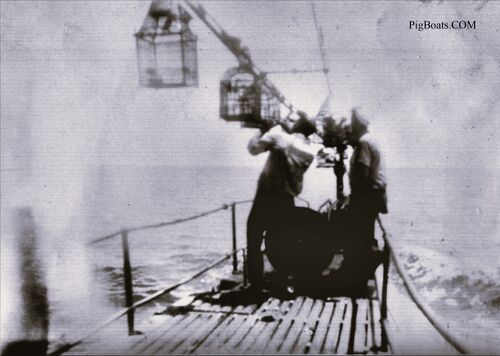
This unfortunately poor quality photo shows a very interesting scene. S-37 is underway likely in the South China Sea near the Philippines. The date is approximately 1925-1926. Several crewmembers are topside tending to canaries in cages! This photo comes from the private collection of former crewmember E.J. Hillin, and a caption written on the back of the photo indicates that the boat had just come from Hong Kong and the crew had purchased a number of canaries in that exotic port, with Hillin indicating that as many as 21 birds were aboard the boat for that voyage. The crew brought at least three of the cages topside to give the birds some fresh air.
Sailors in general, but in particular those in the Asiatic Fleet, are renowned for purchasing unusual souvenirs, especially after a few beers had been consumed. Many of the captains were reasonably tolerant of the practice, knowing that the men needed the morale boost in the harsh conditions of the pigboats. However, this is a little over the top and the birds were likely freed into the Philippine jungles shortly after the boat returned to Cavite. The division or squadron commanders would likely take a fairly dim view of having 21 canaries aboard a submarine.
Photo by E.J. Hillin, and now in the private collection of Ric Hedman.
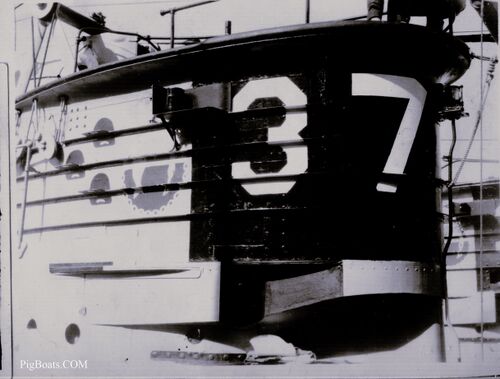
A photo from the E.J. Hillin collection, this one shows a closeup of the S-37's conning tower and bridge fairwater, approximately 1925-1926. The top edge of the bridge is flared outward, to deflect water away from the bridge watchstanders in heavy seas. As the boat pushes through waves while on the surface, wave action has the tendency to "slap" against the fairwater, and if not deflected outward it will come right back down onto the open bridge. Not only does this make for a miserable watch for those men, it will tend to ship a lot of water down into the conning tower and control room. The horizontal strakes on the side of the fairwater also help to break up slapping waves.
Three footholds are attached to the side of the fairwater. These allow a crewmember to climb down to the main deck from the bridge. Forward of the footholds and just aft of the number 3 is the starboard side navigation light. It is green in color; its counterpart on the port side is red. The bracket surrounding it allows the light to only be seen from certain angles, giving an approaching ship an indication from which angle they are viewing the sub. This is important to help avoid collisions at night.
Two of six "deadlight" portholes can be seen near the bottom of the photo. These non-opening deadlights allow light into the watertight conning tower while surfaced. They are of thick tempered glass and are rated to full submergence pressure. Their vulnerability in a depth charge attack seems to have been lost on the designers. Any boats that had them (most up through the early fleet boats) had them blanked off with steel plates soon after the start of the war.
The white numbers on a black background on the forward edge of the fairwater was one of several schemes used to display the boat's name during the 1920s and 1930s. A look through the photos below will show some of the rest. It is not known at this time if these many schemes reflect official U.S. Navy policy, or if they reflect the preferences of local fleet commanders.
Photo by E.J. Hillin, and now in the private collection of Ric Hedman.
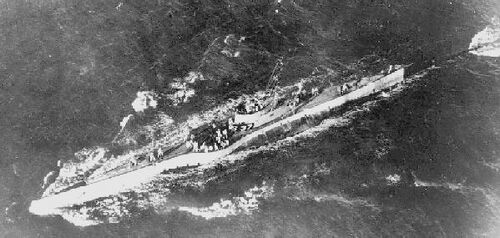
Photo in the private collection of Ric Hedman.
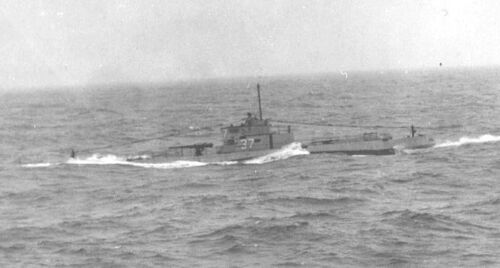
Photo in the private collection of Ric Hedman.
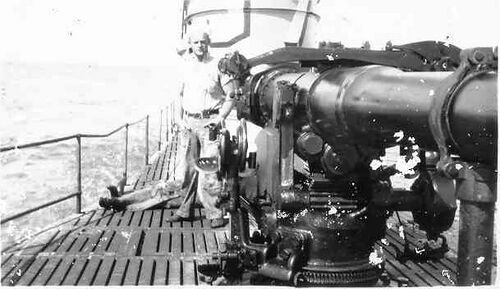
Photo in the private collection of Ric Hedman.
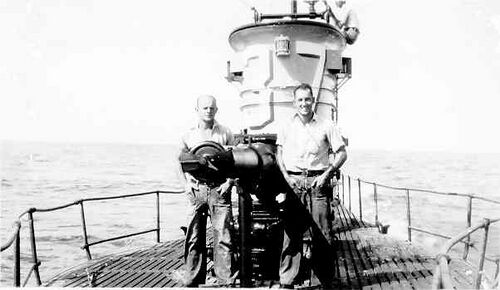
Photo in the private collection of Ric Hedman.
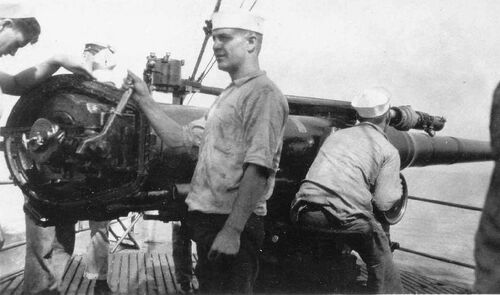
Photo in the private collection of Ric Hedman.
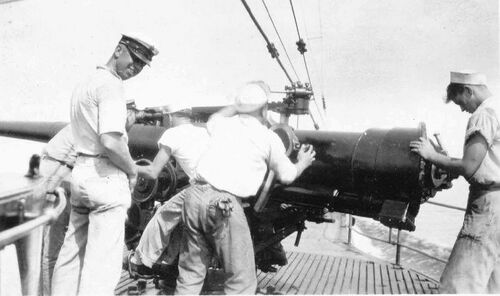
Photo in the private collection of Ric Hedman.
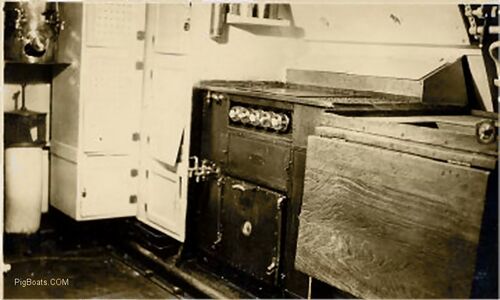
The range is about the size of a large house range and it produced all the food for the crew as many as four times a day. There is a large griddle surface for frying meats, eggs, pancakes, toast, and pretty much anything you'd want to eat. On the right are two flat topped hot plates for cooking in pots and pans. Below is a warming drawer to keep cooked foods warm until served. Below that is the main oven for baking and roasting. On the far left side of the range is a large tank for making hot water with sight glasses and taps.
On the right is the sink that was used for preparing food and washing dishes. In this photo you can see a large, folding cutting board that has been attached to the sink face to increase the amount of room needed for cooking. Space is always at a premium and sub sailors are resourceful people.
This is also the battery compartment and on the deck under the front edge of the stove can be seen the hold downs used to stretch the canvas decking over the boards that were used to cover the battery well. According to men who sailed these boats the decks were a bright green in color.
Photo in the private collection of Ric Hedman.
Page created by:
Ric Hedman & David Johnston
1999 - 2023 - PigBoats.COM©
Mountlake Terrace, WA, Norfolk, VA
webmaster at pigboats dot com
